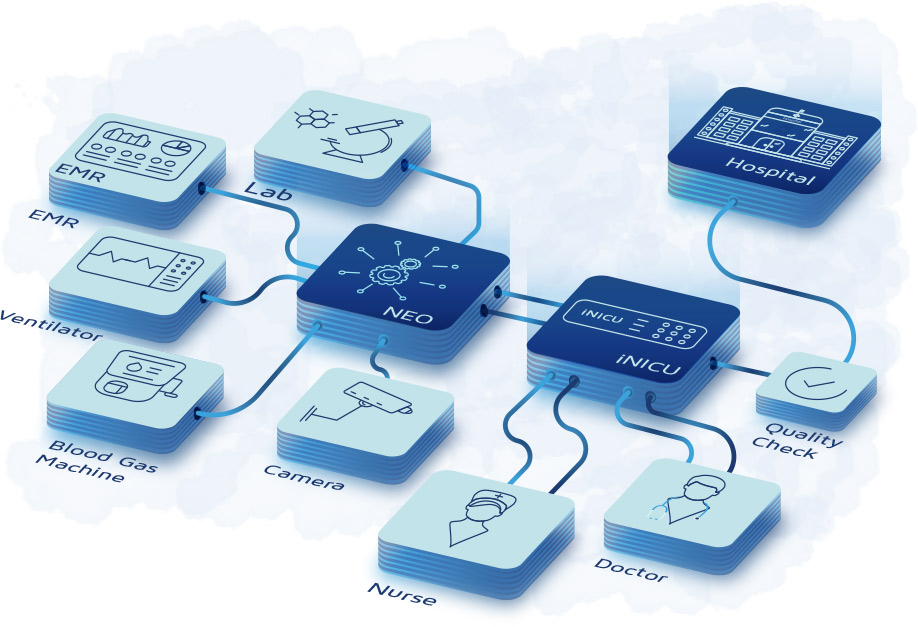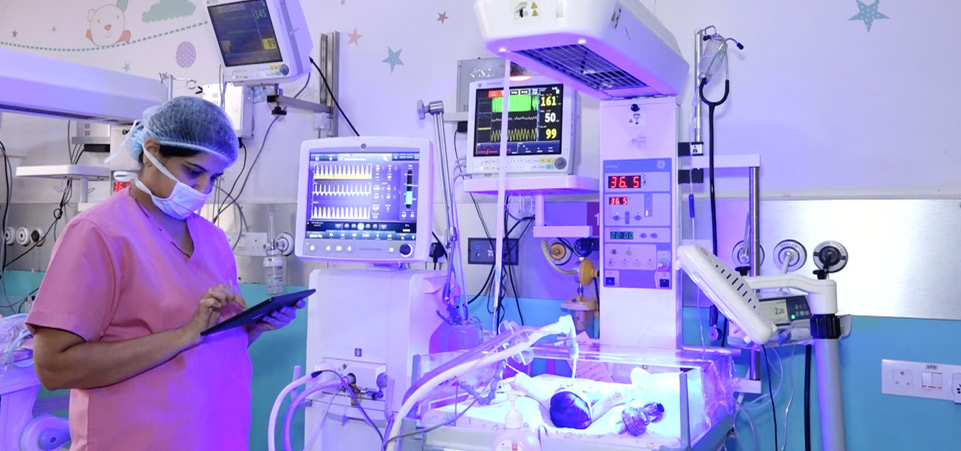Child Health Imprints (CHI): Revitalizing Neonatal Care With IoT Streaming
Enhancing Healthcare and Eliminating Human Error in NICUs
With the internet of things (IoT) poised to permeate every aspect of our lives, Child Health Imprints created a streaming-enabled platform aimed at reducing mortality in preterm infants. The iNICU system aggregates health and video data for doctors working to save newborns’ lives.
150 million
babies are born each year.
1 in 10
newborns are preterm.
37 percent
of the world’s preterm population dies within the first 28 days.
Case Study Snapshot
| Challenges: | Solutions: | Outcomes: |
|
|
|
Identifying a Critical Need for IoT Biomedical Devices
Ravneet Kaur gave birth to twins more than three months ahead of her due date. After her babies were transferred to the neonatal intensive care unit (NICU), Ravneet and her husband, Harpreet Singh, were struck by how lonely and ineffective these facilities can be.
Truth be told, plenty of new families spend time in the NICU. Approximately 15 million babies are born preterm each year, and of those, nearly 2.5 million die before reaching 28 days of age. Ravneet and Harpreet confronted this reality shortly after welcoming their twins into the world, when one of the newborns passed away due to an unavoidable infection.
According to the World Health Organization, reducing mortality starts with quality care. A recent fact sheet states, “Children who die within the first 28 days of birth suffer from conditions and diseases associated with lack of quality care at birth or skilled care and treatment immediately after birth and in the first days of life.”
The couple founded a health tech startup called Child Health Imprints to improve clinical outcomes. They got to work developing an integrated Neonatal Intensive Care Unit (iNICU) with one goal in mind: reducing neonatal mortality.

The cloud-hosted appliance assimilates real-time data from the disparate biomedical devices used to monitor preterm infants — including ventilators, monitors, and blood gas analyzers. In addition to reducing time-to-treatment and improving quality of care, the product enables remote monitoring of neonates in rural regions via video streaming.
Harnessing the Human Element of Medicine Using Streaming Video
The amount of data collected in intensive care is exhausting. Respiration rate, heart rate, lab data, and PACS all contribute to the information tracked for each child. But without video streaming, Child Health Imprints’ iNICU solution would lack a crucial data point for doctors: observation.

“It gives so much more confidence to the doctor if he can see the patient, can see what the intervention is. If I increase the ventilation by this much, how is the patient behaving? If I do a procedure, how is a patient’s facial expression? That’s where the visual is so much more important,” explains Child Health Imprints Cofounder Harpreet.
Technology continues to transform the medical sector. And yet, research has found that a doctor’s intuition and interactions with patients play a significant role in early treatment. By incorporating video streaming, the innovators at Child Health Imprints were able to build this human aspect of medicine into the iNICU platform.
The result? Video, clinical, and vital data are now integrated into one solution — allowing clinicians down the hall and across the world to make informed, real-time decisions that save babies’ lives.
Partnering With Wowza to Streamline Healthcare Workflows
Child Health Imprints had several goals when designing the iNICU platform. After all, there’s no room for error when lives are on the line. In order to successfully incorporate video streaming into their product, Ravneet and Harpreet enlisted the help of Wowza Professional Services.
“Initially, we were doing this in-house development of having a live video stream of the baby and then showing it to the client and customer. But there was a definite lag in speed, and there was a quality compromise,” explains Ravneet, who recognized that video engineering simply wasn’t their strong suit.
Low-latency, high-quality video delivery is a must for any medical-grade platform. But that’s not all. The video needed to be synchronized with clinical and vital data to paint a complete picture. And without documented proof of the solutions’ reliability, complying with regulatory bodies — like the United States’ Food Drug Administration (FDA) and Singapore’s Health Sciences Authority (HSA) — would be a fool’s errand.
Child Health Imprints partnered with Wowza Professional Services to solve these challenges and more. Together, they were able to enhance the lifesaving iNICU system with live streaming.
“I was looking for a partner who could help me in terms of solving a problem,” says Hapreet. “With Wowza, it’s not just about technology. It’s about building relationships, it’s about understanding the customer problem, and investing in that customer problem.”
Child Health Imprints’ iNICU device promises to reduce human error in neonatal care, while maintaining a human touch. Both physicians and premature babies will benefit from the innovative platform. And thanks to video streaming, it will bring skilled doctors to rural populations — affordably and conveniently.




